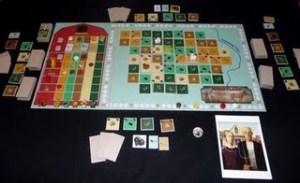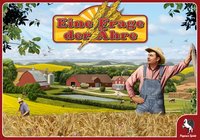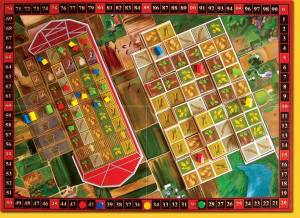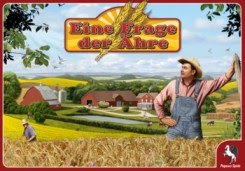 ossia Eine Frage der Ahre (p.s. da qualche parte ci sono anche sue puntini da mettere su una vocale, ma non li trovo sulla tastiera, per cui prendete per buono il titolo così …).
ossia Eine Frage der Ahre (p.s. da qualche parte ci sono anche sue puntini da mettere su una vocale, ma non li trovo sulla tastiera, per cui prendete per buono il titolo così …).
Le domande rivolte a questo autore ricalcano in parte le linee guida di quelle poste agli autori italiani prima ricordati, ma le risposte sono diametralmente opposte, dando ciò l’idea di come le strade per giungere alla pubblicazione di un gioco possano essere estremamente varie. L’intervista in sè è in inglese e (anche per accondiscendere ad un desiderio dell’autore) la ripropongo di seguito in forma originale, esaminandone però qui i contenuti, per cui i non anglofoni già leggendo solo di seguito avranno notizia praticamente di tutti i contenuti principali.
Scopo del nostro Allers era quello, con Eine Frage, di dar vita ad un titolo per famiglie, con regole semplici, ma aperto alla applicazioni di strategie ed alla riflessione. L’idea del gioco (destinato, come concetto, a più giocatori, ma che scala adeguatamente anche in due) in questo caso ha preceduto la sua realizzazione pratica: il nostro eroe infatti proviene dall’Iowa e spiega di aver avuto l’idea del suo tabellone di gioco vedendo dall’alto le piantagioni che caratterizzano il paesaggio di questo stato agricolo americano, le quali, di misura ben precisa (1 miglio quadrato), formano, essendo dedicate a diversi tipi di raccolti, delle specie di patchwork,  esattamente come quello che si vede nel gioco . Partendo da quell’idea quindi sono state, mano a mano, aggiunte le regole, il primo prototipo del gioco ha preso forma ed è stato presentato ad un incontro di game designer, dove la casa produttrice, la Pegasus Spiele, ha per la prima volta proposto di pubblicare il titolo.
esattamente come quello che si vede nel gioco . Partendo da quell’idea quindi sono state, mano a mano, aggiunte le regole, il primo prototipo del gioco ha preso forma ed è stato presentato ad un incontro di game designer, dove la casa produttrice, la Pegasus Spiele, ha per la prima volta proposto di pubblicare il titolo.
Da quel momento è passato parecchio tempo, in quanto dalla creazione alla stampa sono trascorsi, nel complesso, oltre tre anni, nel corso dei quali la casa ha esplorato anche la possibilità di dar vita ad un gioco completamente in legno, scartando poi tale materiale (a favore del classico cartone pressato) dopo aver visto i primi insoddisfacenti specimen dalla Cina.
Quanto poi all’aspetto grafico, curato da Tom Thiel, Allers spiega di non aver avuto modo di lavorare a fianco a lui , limitandosi a dare un’idea di quello che sarebbe stato il suo layout preferito, lasciando poi libero il grafico di dare al titolo la forma finale da lui preferita. Per quanto riguarda l’immagine di copertina il nostro spiega che avrebbe voluto piazzarci il dipinto ‘American Gothic’  , del pittore Grant DeVolson Wood (1891–1942), ma questa sua aspirazione è stata frustrata non essendo stato raggiunto alcun accordo con il Museo detentore dei relativi diritti.
, del pittore Grant DeVolson Wood (1891–1942), ma questa sua aspirazione è stata frustrata non essendo stato raggiunto alcun accordo con il Museo detentore dei relativi diritti.
Il gioco è stato prodotto, agli inizi del 2009, in circa 4000 copie e sembra che abbia avuto un buon riscontro, anche se Allers non è a conoscenza con precisione dei risultati di vendita.
A livello pratico per il Nostro l’attività di game designer, che pure gli ha riservato di recente diverse soddisfazioni, visto che sono stati pubblicati altri tre titoli ai quali ha collaborato, ossia Alea iacta est (un gioco a base di dadi, pubblicato dalla quotata casa Alea), “Aber bitte mit Sahne”e “Circus Maximus” e che ne sta progettando svariati altri, spesso come co-designer, rimane per lui una sorta di hobby, utile per ‘arrotondare’ i guadagni.
Jeffrey, architetto, lavora a Berlino come dipendente per associazioni di stampo religioso ed ha iniziato ad interessarsi di giochi da tavolo da pochissimi anni, iniziando nel 2002 con Carcassonne.
Facendo due considerazioni conclusive direi che è chiaro come il designer ‘contrattista’ si preoccupi essenzialmente di curare le meccaniche del proprio gioco e di trovare un produttore, lasciando poi a lui sia gli oneri della produzione, che una certa libertà di scelta nella cura della veste grafica del titolo. L’autore è poi ripagato con royalties legate ai risultati di vendita e/o con cifre fisse (che, a occhio e croce non consentono di vivere con questo lavoro, se non si diventa autori di un certo successo). In sostanza il ‘creatore’ di giochi svolge solo una fase, quella iniziale, della lunga trafila che porta alla edizione del gioco (lo dimostrano gli oltre tre anni passati dal prototipo acquistato alla sua stampa), mentre al produttore spetta tutto il resto. All’opposto abbiamo invece i ‘pazzi’ (detto simpaticamente, è ovvio), come quelli della Crano Creations, che si buttano a capofitto nell’avventura produttiva, ricoprendo tutti i ruoli in prima persona o con partecipazione diretta (come nel dare una veste grafica al gioco assieme alla disegnatrice prescelta).
Spero che gli approfondimenti svolti siano risultati interessanti e, nel caso, grazie per essere arrivati a leggere fino a qui ! Esprimete pure, se lo volete, (nei commenti) la vostra idea sul livello di gradimento di questo tipo di articoli, un pò diverso dalle solite presentazioni ‘di routine’ di novità del mondo ludico !
Ok, di seguito ecco il testo per esteso dell’intervista, per gli amanti della lingua d’Albione.
————————————————————————————————
There was no particular game that inspired me—it was mainly the theme and the idea of providing interesting decision and multiple ways to score points while still being simple and intuitive. Those are the kinds of games I like to play the most, because I can play them with anyone. It’s a lofty goal to make something interesting enough for “gamers” yet accessible enough for families and those who only play games on occasion, but the feedback I have received seems to indicate that it succeeds at that.
I read that the production process was really long: how much time passed from the first idea of the game to the production of the first copy ?
I always liked seeing where I grew up from an airplane. My home state, Iowa, located in the middle of the United States, looks like a patchwork quilt with its different-colored crops planted in perfect 1-mile-square fields. As I started designing games, I also thought this looked like a game board, and I began thinking about designing something based on my “roots.” It was the end of the Summer, 2005, when I finally made a prototype and tried it out with my friend and fellow game designer Bernd Eisenstein, and he liked it quite a bit. During the next year, I playtested it with Bernd and other Berlin designers such as Hartmut Kommerell and Thorsten Gimmler who encouraged me and gave me suggestions for improving the game. Then I took it to the Game Designer’s Meeting in Goettingen in June, 2006 (see my article on BGN) where several different publishers were interested. Pegasus Spiele was, at the time, planning to break into the family game market, and offered me a contract about a month later. They wanted to produce it within a year, but there was some debate about how and where it would be made, which slowed things down a bit. For example, they had, at one point, planned a more abstract version made entirely of wood, but it would have had to be produced in China in order to be inexpensive enough for the family market. They decided not to do this because the prototypes they received from China were not of high enough quality, from what I understand. In the meantime, they hired a new developer who was now working closely with me to refine the game further. At one point, we even decided together to delay the release of the game further because we wanted to explore a different direction for the game. That is the problem when you have too much time—you never stop tinkering with the designJ In the end, though, we finally went back to the original design, as that was still quite the favorite of the playtesters. The whole process was about 3-1/2 years, which really isn’t too unusual, and I feel that both I and Pegasus put everything into it that we could. It certainly was not a “rush job”!
Had you any chance to influence the kind of design that Tom Thiel gave to the game or was it something dictated from the producer ?
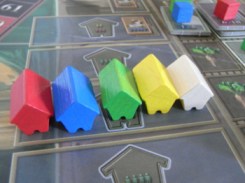 I did not have any contact with Tom Thiel, but I am very happy with his graphic design for the game. With my prototypes, I try to give the playtesters, publishers, and artists an idea of what the game could look like, but I usually fully trust the publisher and the illustrator to make the game’s components attractive and easy to understand. In the early stages, I did, in fact, send some copies of artwork by Iowa artist Grant Wood to Pegasus as a suggestion. They particularly liked the famous rural scene “American Gothic” and even tried to acquire the rights to use it on the cover, but their negotiations with the Art Institute of Chicago were unsuccessful.
I did not have any contact with Tom Thiel, but I am very happy with his graphic design for the game. With my prototypes, I try to give the playtesters, publishers, and artists an idea of what the game could look like, but I usually fully trust the publisher and the illustrator to make the game’s components attractive and easy to understand. In the early stages, I did, in fact, send some copies of artwork by Iowa artist Grant Wood to Pegasus as a suggestion. They particularly liked the famous rural scene “American Gothic” and even tried to acquire the rights to use it on the cover, but their negotiations with the Art Institute of Chicago were unsuccessful.
The game has been on the shelves for a few months now: can you tell something about how well it sold ? How many copies were printed ?
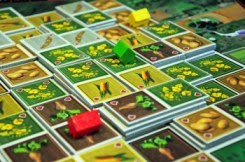 I don’t have current sales figures, as my license fee is only reported to me periodically. I believe at least 4,000 copies were printed initially.
I don’t have current sales figures, as my license fee is only reported to me periodically. I believe at least 4,000 copies were printed initially.
And about the rules: the game seems to work fine also for two players, but it seems to have been created for more players. Is this a wrong perception from me ?
I think most multi-player games are designed mainly for multiple players, and this game is no exception. Games made specifically for two players usually work very differently, and it is difficult to stretch them into multi-player games. Likewise, it is often difficult to make a multi-player game enjoyable with only two. I usually design games for multiple players because I enjoy the social experience of gaming in a group. That said, I believe that the 2-player version of “Eine Frage der Ähre“ works very well. My wife even enjoys it, and she does not play as many games as I do.
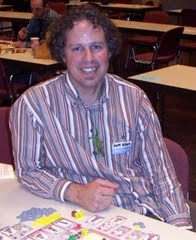 Now something about you: please present yourself …
Now something about you: please present yourself …
I studied Architecture and Journalism at Iowa State University, then moved to Berlin right after graduation. After designing museum exhibitions and buildings in the former East Berlin, I changed careers to youth work in Berlin with a German-American church partnership. I’ve recently changed jobs again to work at a Christian community center in Berlin, where I am program co-director and work with youth and families. What’s nice, is that one of the “programs” I can offer is a bi-weekly game night! Although I have lived in Berlin since 1994, it wasn’t until we were visiting German friends one evening in 2002 that I became “hooked” on board games. They introduced us to “Carcassonne,” and after that, we began attending game nights at a local game store. Then I found another gaming group attended by Berlin game designers, and the rest is history. I’m married and have twin sons, and they are already interested in playing games with daddy. They bypass all the cute yellow Haba games I bought for them, though, and head straight to the Alea games on my shelf!
After Eine Frage are you working on another game ? Can you give us (little) sneak peek ?
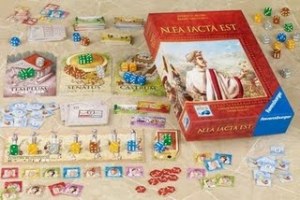 I have more ideas than I have time to develop. After having my first 4 games published within a year’s time, though (“Alea Iacta Est,” “Aber bitte mit Sahne,” “Circus Maximus”), I do feel a little pressure to get something out there again. I have a few games under consideration by publishers, and I have been notified that my card game “Wampum,” which won second prize in the Hippodice Game Design Competition this year, will be published. Otherwise, I’m working on the following: a more complex resource-management game about the founding of New Amsterdam by the Dutch West India Company, a shorter “gamer’s game” together with Bernd Eisenstein, a family-oriented game about an interesting aspect of Mardi Gras with Tim Drechsel, several ideas with Peer Sylvester, and many more that I dabble with when I have time. I am busier than ever with work and family, and so it is more efficient and more fun to work together with co-designers.
I have more ideas than I have time to develop. After having my first 4 games published within a year’s time, though (“Alea Iacta Est,” “Aber bitte mit Sahne,” “Circus Maximus”), I do feel a little pressure to get something out there again. I have a few games under consideration by publishers, and I have been notified that my card game “Wampum,” which won second prize in the Hippodice Game Design Competition this year, will be published. Otherwise, I’m working on the following: a more complex resource-management game about the founding of New Amsterdam by the Dutch West India Company, a shorter “gamer’s game” together with Bernd Eisenstein, a family-oriented game about an interesting aspect of Mardi Gras with Tim Drechsel, several ideas with Peer Sylvester, and many more that I dabble with when I have time. I am busier than ever with work and family, and so it is more efficient and more fun to work together with co-designers.
Designing this game was a step toward a job (game designer) or simply the fullfillment of the little dream of every game creator to see his game published (remaining the game designing only an hobby) ?
Being a former architect, designing games was a natural progression from discovering the variety of German games and playing them regularly. I was also encouraged by all the established designers who kept bringing their prototypes to our weekly game group. It’s simply a fun hobby, and I enjoy the design process and the interaction I have with playtesters, other designers, and publishers. I love my “day job” and doubt that I would ever make enough money from game design to support my family, anyway, although any extra income is nice. It’s never too early to start a college fund for the boys.
— Le immagini sono tratte dal blog dell’autore (o da BGG, di tale KAS). Tutti i diritti appartengono alla casa produttrice e sono state riprodotte ritenendo che la cosa possa rappresentare una gradita forma di pubblicizzazione del gioco —
— Nota: questo è il secondo articolo dedicato a questo gioco comparso su questo forum. Per ulteriori info cerca l’altro, utilizzando i menù (etichette) a destra .. —
